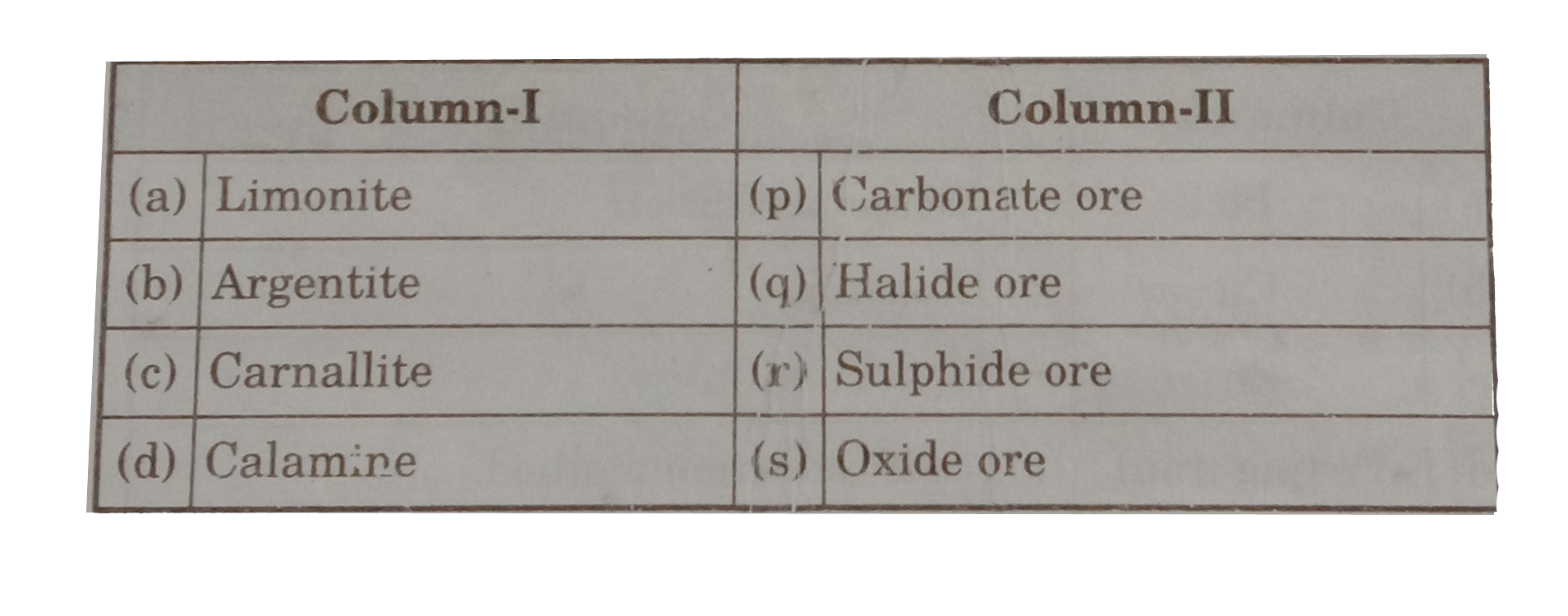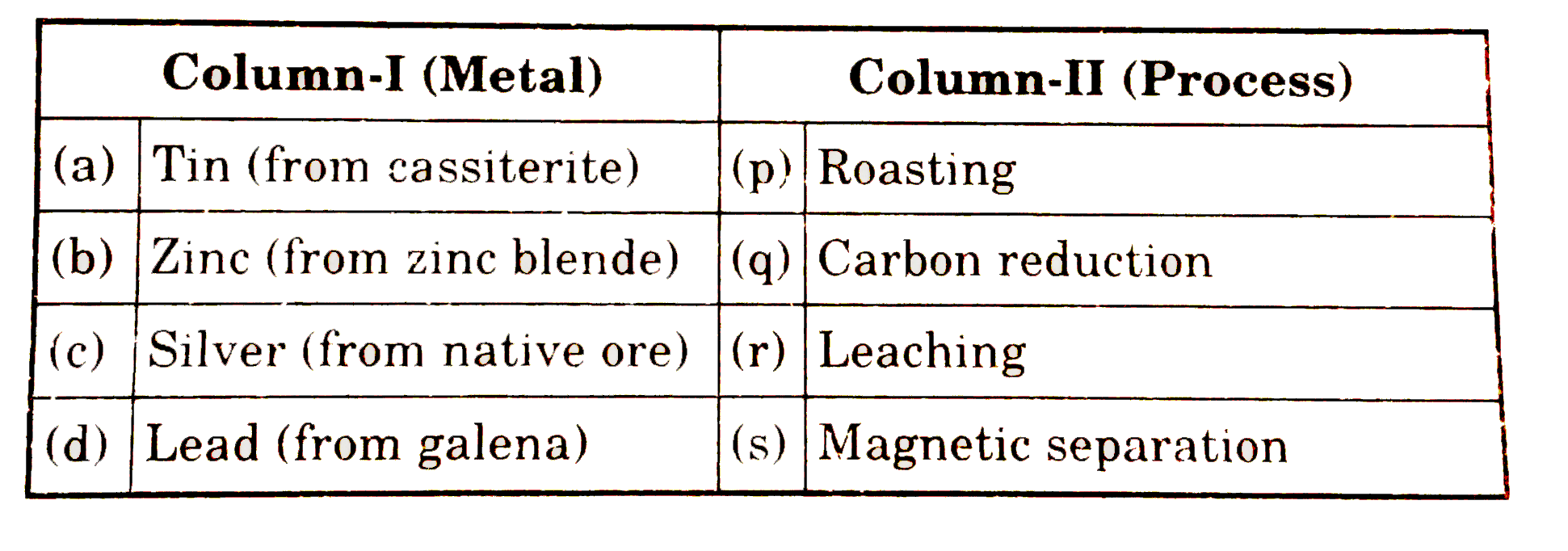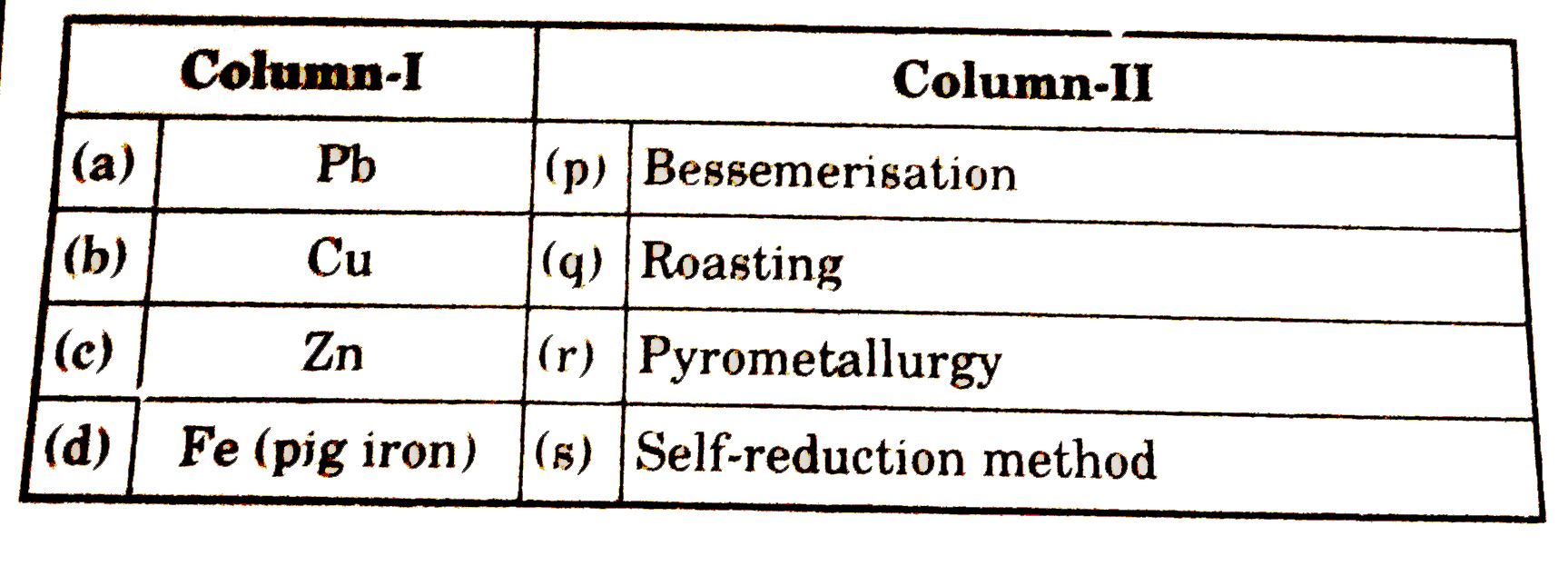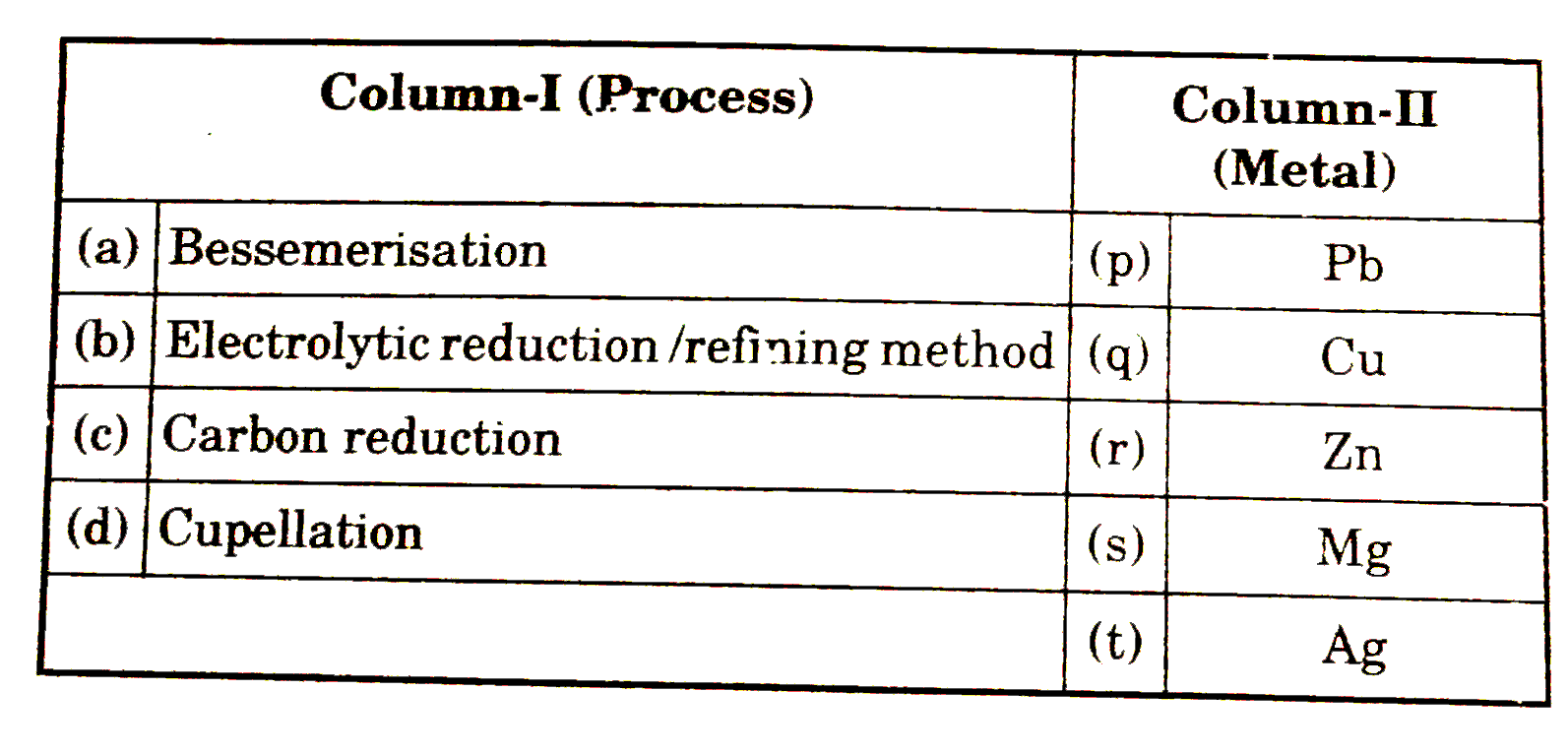Subjective type from GRB CHEMISTRY (HINGLISH) METALLUGY for Class 12
| Class 12 | CHEMISTRY |
| Chapter | METALLUGY |
| GRB CHEMISTRY (HINGLISH) | Subjective type |
| Medium | English |
| Academic Year | 2023-2024 |
Question 68
Choose the correct option the code regarding roasting process.
(I) It is the process of heating the ore in air in a reverberatory furnace to obtain the oxide.
(II) It is an exothermic process.
(III) It is used for the concentration of sulphide ore.
(Iv) It removes easily oxidisable volatile impurities present in the concentrated ore.View SolutionQuestion 117
Which of the following plots between ΔG∘andT(^(∘)C) represents the sequence of oxide of formation of a metal in its different phase as given below? Assume the metallic oxide is thermally stable in different stages
M(s)+O2(g)I−−→MO2(s)
M(l)+O2(g)II−−→MO2(s)
M(g)+O2(g)III−−→MO2(s) View SolutionQuestion 119
The standard free energy of formation of MgO AND CO at temperature 1000∘Cand2000∘C are given below (they refer to the reaction involving one mole of oxygen at one atomsphere pressure) The free energy change to the reaction.
2Mg+O2→2MgO ΔG1000∘C=−941kJ/mol
ΔG2000∘C=−341kJ/mol
2C+O2→2CO ΔG1000∘C=−439kJ/mol
ΔG2000∘C=−628kJ/mol View SolutionQuestion 135
In pyro metallurgy the metals are extracted from ores and concentrates by heat treatment. This involves conversion to metal oxide. This is followed by the reduction of the oxide to the metal using carbon or carbon monoxide.
4Cr(s)+3O2(g)→4Cr2O3(s),
ΔG∘=1500kJ/mol at1200∘C
2Mn(s)+O2(g)→2MnO(s),
ΔG∘=−600kJ/mol at1200∘C
2C(s)+O2(g)→2CO(g),
ΔG∘=−550kJ/mol at1200∘CView SolutionQuestion 160
Consider the following statement: Statement-1: In extraction of iron from haematite ore, the reduction reactions take place only in the lower temperature range in the blast furnace.
Statement-2:Calamine is an carbonate ore of zinc. ltbr Statement-3: The principle opre of aluminium, bauxite, usually contains silica, iron oxides and titanium, oxide as impurities.
Statement-4:Solidified copper obtained from silica lined convertor (Bessemer converter) has blistered appearance due to the evolution of SO2 and arrange in the order of true/false.View SolutionQuestion 161
Consider the following statement:
Statement-1:In electrolytic refining, the impurities from th blister copper deposits anode mud which contains antinomy, selenium, telluriun, silver, gold and plantinum. (From copper pyrites)
Stament-2: In Serpeck's process, silica is removed by heating the bauxite to 1800∘C with coke in a current of N2.
Statement-3:Chalcocite and azurite are ores of copper.
Statement-4:The tin is obatined by the carbon redcution of black tin. and arrange in hte order of true/false.View SolutionQuestion 162
Consider the following statement:
Statement-1: Extraction of zinc from sphalerite involves roasting followed by carbon redcution.
Statement-2:In bessemer convertor, along with copper FeSiO3 is also obtained.
Statement-3: In extraction of lead, CaO prevents formation of PbSiO3.
Statement-4:Copper is extracted by hydrogen metallurgy from low grade ores and scraps.
and arrange in the order of true/false.View SolutionQuestion 164
Select the correct option for the given processes.
(P) Process of heating stell to redness and then cooling it very slowly.
(Q) Process of heating steel in presence of NH3 and producing hard coasting of iron nitrate on the surface of steel.
(R ) Process of heating steel to redness and then cooling it suddenly by plunging it into water or oil.
(S) Process of heating quencheed steel to a temperature well below redness and then cooling it slowly.View SolutionQuestion 169
Give the correct of initials T or F following statemetns. Use T if statement is true and F if it is false.
(P) Cu metal is extracted from its sulphide by reduction of Cu2OwithFeS.
(Q) An ore of Tin containing FeWO4 is concentrated by magnetic separation method.
(R ) Auto redcuton process is used in the extraction of Cu and Hg.
Cassiterite and Rutile are oxide ore of the metals.View SolutionQuestion 220
Consider the following metallurgical process:
(P) Heating impure metal with CO and distilling the resulting volatile cabonyl (b.p.43∘C) and finally decomposing at 150∘−200∘C to get the pure metal.
(Q) Heating the sulphide ore in air unitl a part is converted to oxide and then further heating in the absence of air to let the oxide react, with unchanged metal sulphide.
(R) Electrolysis of the molten electrolyte containing approximately equal amounts of the metal chloride and NaCl to obtian the metal
The processes used for obtaining manesium nickel and copper are respectively:View SolutionQuestion 241
Read the following statements:
Choose the correct set of statement(s):
(P) Al has greater affionity than that of Fe. For oxygen
(Q) Cast iron of nickel impurity of zinc and lead
(R ) Refining of nickel is done by vapour phase refning
(S) In cyanide proces, oxygen and zinc dust are used as oxidising agent and reducing agent respectively:View SolutionQuestion 267
Give the correct order of initials T and F for for following statements. Use T if stament is true and F it is false.
(P) In Gold Schmidt thermite process, aluminium acts as a reducing agent.
(Q) Mg is extracted by electrolysis of aq. Solution MgCl2.
(R) Extraction of Pb is possible by smelting.
(S) Red bauxite is purified by Serpeck's process.View SolutionQuestion 272
Consider the following isolatin/purification pocess:
(P) Heating impure metal with I2at150−200∘C and passing the resulting volatile iodidle on hot tungsten filament at 1400∘C to get the pure metal.
(Q) Heating the sulphide ore in air unitil a part is converted to oxide and then further heating in the absence of air to let the oxide react with unchanged metal sulphide to get the metal.
(R) Electrolysis of the molten electrolyte containing metal oxide and cryolite or flourspar to obtain the metal
The process used for obtaining aluminium, titanium and lead are respectively,View SolutionQuestion 284
Consider the following statement:
Statement-1: Poiling process is used to refinning of copper and lead.
Statement-2: The scavenger which is used in the manufacture of steel is maganese.
Statement-3: The chemical comosition of mattert in Cu2O+Cu2S.
Statement-4: In the extraction of aluminium from aluminia Al2O3 undergoes dissociation.
And arrange in the order of ture/false View SolutionQuestion 311
Statement-1:In cyanide process for the extraction of gold and silver from their natives, ores, the cuanide solution acts as a reducing agent to reduce the gold and siver compound present in the ores into the metallic states.
Statement-2:In the extraction of gold and silver, the cyanide solution acts as complexing ragent in the presence of air and form their respective soluble complexes.View SolutionQuestion 318
Assertion: In extraction of copper from chalcopyrite after roasting in supply of air ai moderate temperature, the temperature of the roasting ore is increased above the fusion temperature and then silica is added in reverberatory furnace.
Reason: In the extraction of copper from chalcopyrites during smelting, the impurity of iron is removed as fusible slag (FeSIO3) in blast furnace or reverberatory furnace. View SolutionQuestion 320
Statement-1: The reduction of a metal oxide is easier if the metal formed is in liquid state at he temperature of reduction.
Statement-2: The value of entropy change ΔS of the reduction process is more on +ve side when the metal formed is in liquid state and the metal oxide being reduced in a solid state. Thus, the value of the ΔG becomes more or negative side.View SolutionQuestion 323
Statement-1: Oxide ore of iron are concentrated through calcination/roasting in an reverberatory furncae.
Statement-1: The water of crystallisation of hydrated oxide ore get get lost as mositure, carbonate ore get decomposed to form oxide and sulphide if present is oxidised.View SolutionQuestion 430
An element (X) which is the most abundant metal in the earth's crust and the third most abudant element, is extracted by the electrolysis of its fused oxide in melted cryolite and fluorspar. XCl3 exists as (XCl3)n in crystalline state and is only dimeric (X2Cl6) in fused state
X+3HCl+6H2O→XCl3.6H2O(s)+32H2
Anhydrous XCl3 fumes in moist air and is very hygroscopic
When XCl3.6H2O(s) is heated strongly, hte products formed are: View SolutionQuestion 431
An element (X) which is the most abundant metal in the earth's crust and the third most abudant element, is extracted by the electrolysis of its fused oxide in melted cryolite and fluorspar. XCl3 exists as (XCl3)n in crystalline state and is only dimeric (X2Cl6) in fused state
X+3HCl+6H2O→XCl3.6H2O(s)+32H2
Anhydrous XCl3 fumes in moist air and is very hygroscopic
Consider of the following is correct?

Which of the following is correct?View SolutionQuestion 433
All minerals are not ore but all ores are minerals. The extraction of a particular metal depends upon several factor and overall it has to be convenitent and economical. Following common steps are involved in extraction of metal from its prime ore:
(a) Pulverisation
(b) Concentration
(c) Calcination/Roasting
(d) Smelting and Reduction
(e) Purifaction of crude metal
Which of the following options is correct? State true and false
(P) Fe2O3 can be reduced by coke as well as aluminium.
(Q) Red bauxite is is concentrated by leaching method.
(R ) Impure Zn is purified by either distilation or electrolytic is refining method.
(S ) Wrought iron is a purest form of iron. View SolutionQuestion 434
Copper is the most noble of the first row transition metals and occurs in small deposits in several countries. Ors of copper include chalcanthite (CuSO4.5H2O) , atacamite (Cu2Cl(OH)3), cuprite (Cu2O), copper glance (Cu2S) and malachite (Cu2(OH)2CO3). However , 80% of the world copper production comes from the ore chalcopyrite (CuFeS2). the extraction of copper from chalcopyrite involves partial roasting, removla of iron and self- reduction.
Partial roasting of chalcopyrite producesView SolutionQuestion 435
Copper is the most noble of the first row transition metals and occurs in small deposits in several countries. Ors of copper include chalcanthite (CuSO4.5H2O) , atacamite (Cu2Cl(OH)3), cuprite (Cu2O), copper glance (Cu2S) and malachite (Cu2(OH)2CO3). However , 80% of the world copper production comes from the ore chalcopyrite (CuFeS2). the extraction of copper from chalcopyrite involves partial roasting, removla of iron and self- reduction.
Iron is removed from chalcopyrite asView SolutionQuestion 436
Copper is the most noble of the first row transition metals and occurs in small deposits in several countries. Ors of copper include chalcanthite (CuSO4.5H2O) , atacamite (Cu2Cl(OH)3), cuprite (Cu2O), copper glance (Cu2S) and malachite (Cu2(OH)2CO3). However , 80% of the world copper production comes from the ore chalcopyrite (CuFeS2). the extraction of copper from chalcopyrite involves partial roasting, removla of iron and self- reduction.
In self- reduction, the reducing species is View SolutionQuestion 441
Question given below are based on the given diagram of extractive metallurgy.

The point noted by arrow are the melting and boiling points of the metals zinc and magnesium. ΔG∘ as a function of temperature for some reaction of extractive metallurgy.
At what temperature, zinc and carbon have equal affinity for oxygen?View SolutionQuestion 442
Question given below are based on the given diagram of extractive metallurgy.

The point noted by arrow are the melting and boiling points of the metals zinc and magnesium. ΔG∘ as a function of temperature for some reaction of extractive metallurgy.
At this temperature ΔG∘ of the reaction is:
ZnO+C→Zn+COView SolutionQuestion 443
Question given below are based on the given diagram of extractive metallurgy.

The point noted by arrow are the melting and boiling points of the metals zinc and magnesium. ΔG∘ as a function of temperature for some reaction of extractive metallurgy.
To make the following reduction process spontaneous, temperature should be:
ZnO+C→Zn+COView SolutionQuestion 450
Some of the lower quality ore are mixed with Haematite for Fe extraction like Siderate, Limonite and Magnetic. Roasted ore are mixed with coke and lime stone, finally heated in the blast furnace to get molten Fe.
Choose the correct statement reagarding the roasting process here. View SolutionQuestion 451
Some of the lower quality ore are mixed with Haematite for Fe extraction like Siderate, Limonite and Magnetic. Roasted ore are mixed with coke and lime stone, finally heated in the blast furnace to get molten Fe.
Which of the following reaction is least favoured at the heath?View SolutionQuestion 454
Benefication of the ore can be done by different ways. It is increasing the concentration of ore by removing impurities, while refining is the process by which concentration of metal is incresed in the final product.
Which of the following compound will be reduced by carbon reduction?View SolutionQuestion 456
Benefication of the ore can be done by different ways. It is increasing the concentration of ore by removing impurities, while refining is the process by which concentration of metal is incresed in the final product.
What is the correct match for the name of the ore in column I and formula in column II?View SolutionQuestion 457
Benefication of the ore can be done by different ways. It is increasing the concentration of ore by removing impurities, while refining is the process by which concentration of metal is incresed in the final product.
The phase principle to apply vapour phase refining is/are:View SolutionQuestion 458
Metallic gold ferquently is found is aluminosilicate rocks and it is finely dispersed among other minerals. It may be extracted by treating the crushed rock with aearated sodium cyanide solution. During this process metallic gold is slowly converted to [Au(CN)2]−, Which is soluble in water. After equilibrium has been reached, the aqueous phase is pumped off and the metallic gold is recoverd form it by reacting the gold complex with zinc, whihc is converted tio [Zn(CN)4]2−. Gold in nature is frequently alloyed with silver. which is also oxidised vy aerated sodium by aerated sodium cyanide solution.
The correct ionic reaction for the process are: View SolutionQuestion 459
Metallic gold ferquently is found is aluminosilicate rocks and it is finely dispersed among other minerals. It may be extracted by treating the crushed rock with aearated sodium cyanide solution. During this process metallic gold is slowly converted to [Au(CN)2]−, Which is soluble in water. After equilibrium has been reached, the aqueous phase is pumped off and the metallic gold is recoverd form it by reacting the gold complex with zinc, whihc is converted tio [Zn(CN)4]2−. Gold in nature is frequently alloyed with silver. which is also oxidised vy aerated sodium by aerated sodium cyanide solution
There have been several to develop alternative gold extraction processs whihc could replace this one. This due to:View SolutionQuestion 460
Metallic gold ferquently is found is aluminosilicate rocks and it is finely dispersed among other minerals. It may be extracted by treating the crushed rock with aearated sodium cyanide solution. During this process metallic gold is slowly converted to [Au(CN)2]−, Which is soluble in water. After equilibrium has been reached, the aqueous phase is pumped off and the metallic gold is recoverd form it by reacting the gold complex with zinc, whihc is converted tio [Zn(CN)4]2−. Gold in nature is frequently alloyed with silver. which is also oxidised vy aerated sodium by aerated sodium cyanide solution
The process described in the passage represents:View SolutionQuestion 461
Amongst the various ores of a metal (M) (sulphide, carbonates, oxides, hydrated or hydrixides) two ores [X] and [Y] show the following reactivity?
(a) [X[] on calcination gives a black solid (S), water and a colourless gas which produces milkiness when passed through lime water. But this colourless gas does not decolorise acidified KMnO4.
(b) [X] dissolved in diliute HCl. On reaction with KI gives a white precipitate(P) and iodine gas.
(c) [Y] on roasting at high temperature gives metal (M) and gas (G1) which turns starch iodate solution blue.
(d) [Y] on reaction with dilute HCl gives a white precipatate (MS) and another gas (G1) to precipitate colloidal sulpher in presence of moisture.
M,S[X],[Y] gives greenish blue flame.
The metal ore [X] and [Y] are respectively: View SolutionQuestion 462
Amongst the various ores of a metal (M) (sulphide, carbonates, oxides, hydrated or hydrixides) two ores [X] and [Y] show the following reactivity?
(a) [X[] on calcination gives a black solid (S), water and a colourless gas which produces milkiness when passed through lime water. But this colourless gas does not decolorise acidified KMnO4.
(b) [X] dissolved in diliute HCl. On reaction with KI gives a white precipitate(P) and iodine gas.
(c) [Y] on roasting at high temperature gives metal (M) and gas (G1) which turns starch iodate solution blue.
(d) [Y] on reaction with dilute HCl gives a white precipatate (MS) and another gas (G1) to precipitate colloidal sulpher in presence of moisture.
M,S[X],[Y] gives greenish blue flame.
Which of the following statements is correct about [Y]?View SolutionQuestion 463
Amongst the various ores of a metal (M) (sulphide, carbonates, oxides, hydrated or hydrixides) two ores [X] and [Y] show the following reactivity?
(a) [X[] on calcination gives a black solid (S), water and a colourless gas which produces milkiness when passed through lime water. But this colourless gas does not decolorise acidified KMnO4.
(b) [X] dissolved in diliute HCl. On reaction with KI gives a white precipitate(P) and iodine gas.
(c) [Y] on roasting at high temperature gives metal (M) and gas (G1) which turns starch iodate solution blue.
(d) [Y] on reaction with dilute HCl gives a white precipatate (MS) and another gas (G1) to precipitate colloidal sulpher in presence of moisture.
M,S[X],[Y] gives greenish blue flame.
The gas (G1) can act as:View SolutionQuestion 464
Dow's process f extraction of Mg involves extraction of Mg from sea water. Sea water is concentrated is sun light and is then treated with milk of lime. Magnesium hydroxide obatained is reacted with dilute HCl and MgCl2 thus obtained is crystallised. The molten mixture containing angydrous 35% MgCl2, 50% NaCl and 15% CaCl2 is electrolysed when magnesium is discharged at cathode. NaCl and CaC2 are added to lower the fusion temperature and to increase to the conductance. Mg electrolysed is protected from atmospheric oxidation by a blanket of inert gases.
Select the correct statement. View SolutionQuestion 465
Dow's process of extraction of Mg involves extraction of Mg from sea water. Sea water is concentrated in sun-light and is then treated with slaked lime. Magnesium hydroxide is heated in a stream of HCl to give MgCl2 which is electrolysed to discharge Mg. The mixture is in the ratio 35% MgCl2+50%NaCl+15%CaCl2. NaCl and CaCl2 are added to lower the fusion temperature and to increases the conductance.
Mg2++Ca(OH)2→Mg(OH)2+Ca2+
Mg(OH)2+2HCl→MgCl2+2H2O(l)
Electrolysis of fused MgCl2⇔Mg2++2Cl
Mg2++2e−→Mg( At Cathode)
2Cl−→Cl2+2e− (At Anode)
Mg electrolysed is protected from atmospheric oxidation by a blanket of inert gases.
In the hydrated chloride of Mg the value of x is :View SolutionQuestion 466
Dow's process f extraction of Mg involves extraction of Mg from sea water. Sea water is concentrated is sun light and is then treated with milk of lime. Magnesium hydroxide obatained is reacted with dilute HCl and MgCl2 thus obtained is crystallised. The molten mixture containing angydrous 35% MgCl2, 50% NaCl and 15% CaCl2 is electrolysed when magnesium is discharged at cathode. NaCl and CaC2 are added to lower the fusion temperature and to increase to the conductance. Mg electrolysed is protected from atmospheric oxidation by a blanket of inert gases.
Molten mixture of NaCl and CaCl2 is added to hte molten MgCl2 beacuse:View SolutionQuestion 473
The first stage in the conversion of iron ore to steel is the carbon reduction in blast furnace, which accounts for the largest tonnage of any metal produced by man. In it the iron ore is redcued by CO/coke while limestone removes by sand or clay as slag. The molten iron is run off to be cast into moulds of the required shape or into ingouts ("pigs") for further processing.
Select the correct for the % of carbon in different form if iron. View SolutionQuestion 474
The first stage in the conversion of iron ore to steel is the carbon reduction in blast furnace, which accounts for the largest tonnage of any metal produced by man. In it the iron ore is redcued by CO/coke while limestone removes by sand or clay as slag. The molten iron is run off to be cast into moulds of the required shape or into ingouts ("pigs") for further processing.
Select incorrect option: View SolutionQuestion 477
At high temperature carbon reacts with water to prodcue a mixture of carbon monoxide, CO and hydrogen, H2.
C+H2Ored heat−−−−→CO+H2
CO is separted from H2 and then used to separtee nickel from cobalt by forming a volatile compound, nickel tetracarbonyl, Ni(CO_(3))
Ni+4CO→Ni(CO)4
How many moles of Ni(CO)4 could be obatined from the CO produced by the reaction of 75g of carbon? Assume 100% reaction and 100% recovery in both steps. View SolutionQuestion 478
At high temperature carbon reacts with water to prodcue a mixture of carbon monoxide, CO and hydrogen, H2.
C+H2Ored heat−−−−→CO+H2
CO is separted from H2 and then used to separtee nickel from cobalt by forming a volatile compound, nickel tetracarbonyl, Ni(CO_(3))
Ni+4CO→Ni(CO)4
Formation of volatile Ni(CO)4 and its subsquent heating give Ni. Process is called:View SolutionQuestion 522
In order to obtain metal from its oxide through Blast furnace process, the following reactions are involved.
Fe2O3+CO→Fe3O4+CO2
Fe3O4+CO→Fe+CO2
FeO+CO→Fe+CO2
If the % yield of the first, second and third reactions are 80% and 60% ,50% respectively then calculate mass of iron (in gm) which will be obtained if 16g of Fe2O3 is reacted with excess of CO. View SolutionQuestion 525
In order to concentrate galena (which contains ZnS as impurity) by froth floatation process, sodium cyanide is used as department. NaCN dissolves ZnS due to formation of water soluble complex (A).
Find wxyz,
Where w=corrdination number of central metal ion in complex ion of (A)
x=number of unpaired electrons in (A)
y=total number of possible linkage isomers of (A) including (A)
z=maximum number of atoms in a single plane in the complex ion of (A).View SolutionQuestion 528
Find the total number of feasible reaction which would yeild free metal.
(a) HgS+O2600∘C−−−→ΔHg+SO2
(b) HgS+2HgOΔ−−→3Hg+SO2
(c ) CuSO4+3CO→3Cu+2SO2
(d) Fe2O3+3COΔ−−→2Fe+3CO2
(e) Fe2O3+3CΔ−−→2Fe+3CO
(f) ZnSO4+2CΔ−−→Zn+SO2+2CO
(g) 4Cu2O+CH4→8Cu+2H2O+CO2
(h) 2Na[Au(CN)2]+Zn→Na2[Zn(CN)4]+2AuView SolutionQuestion 549
How many of the given consequences are in general the result of roasting and/or calcination of concentrated ores?
(a) Removal of mositures
(b) Reduction of metal oxides into metal
(c ) Removal of volatile impurities as elemental vapour or volatile oxides
(d) Conversion of concentrated ores into correspondin oxides
(e) Melting of concentrated ores
(f) Ores become porousView Solution




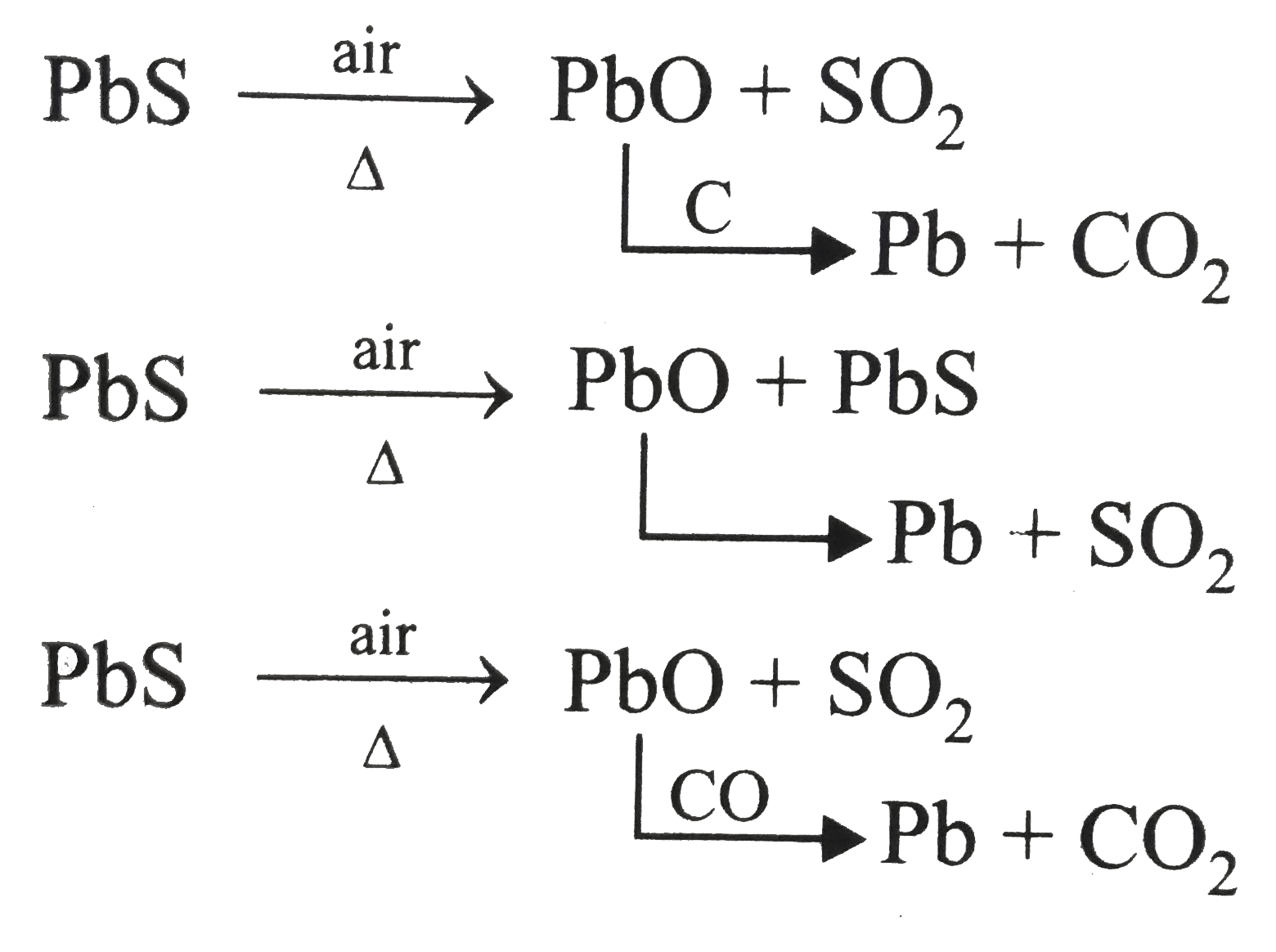



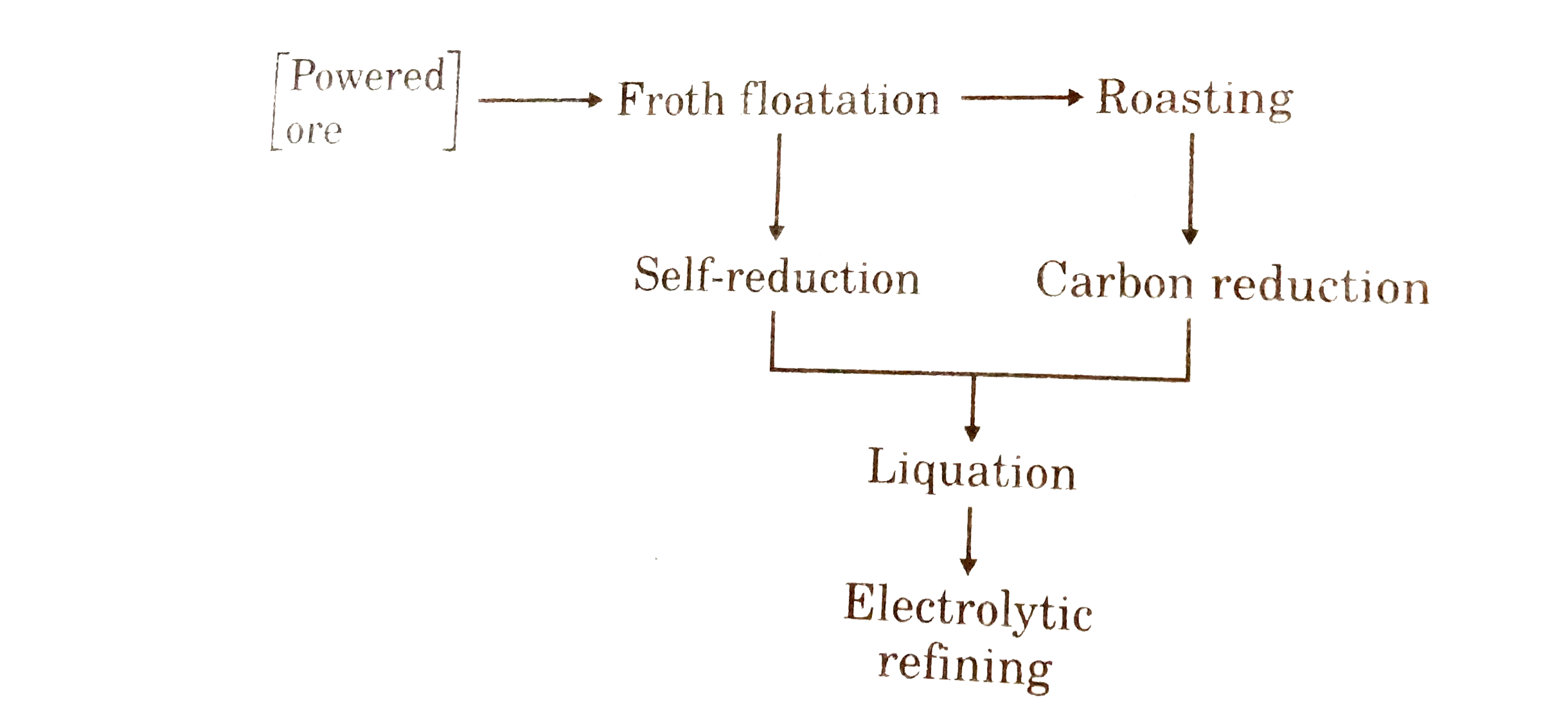
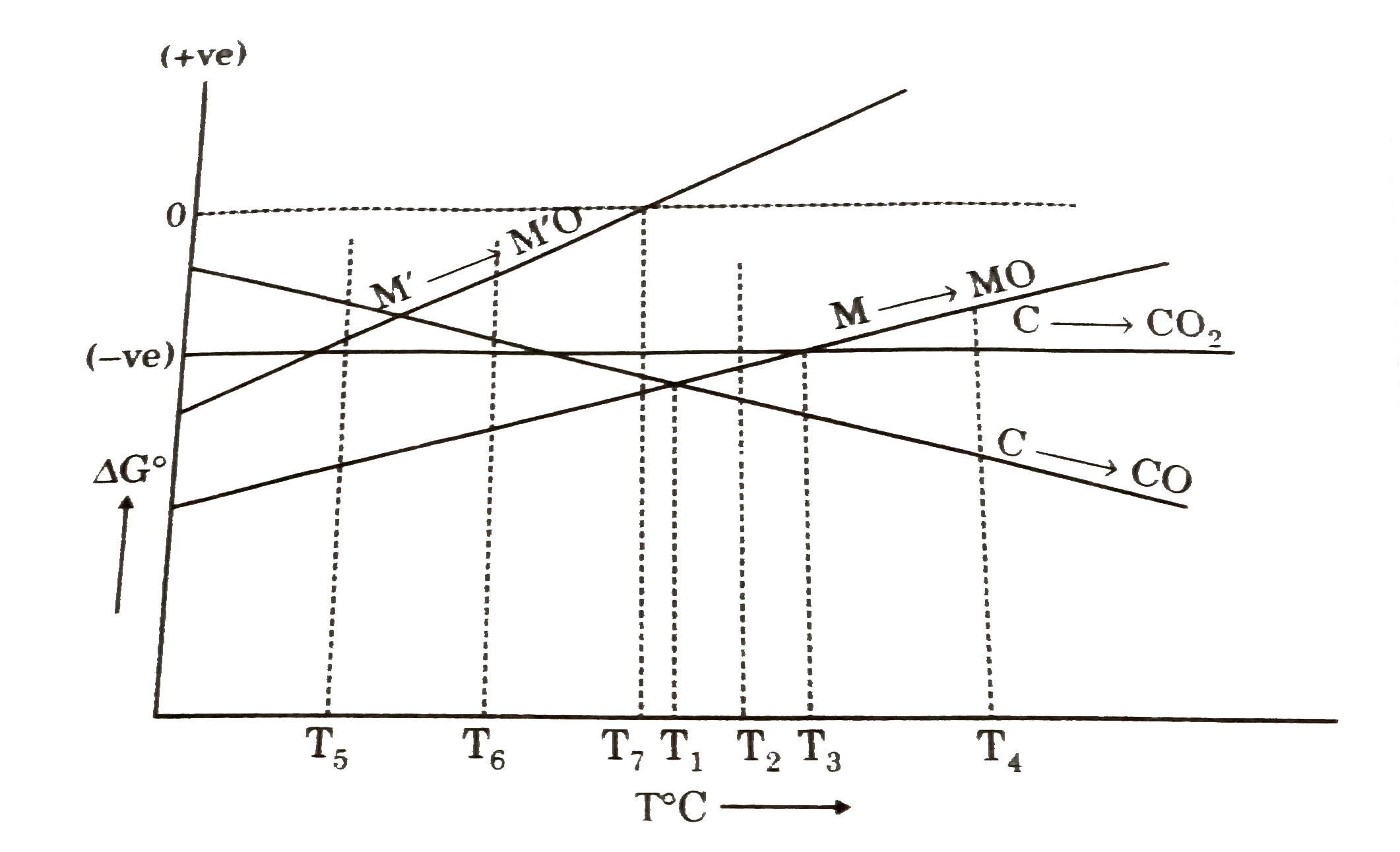
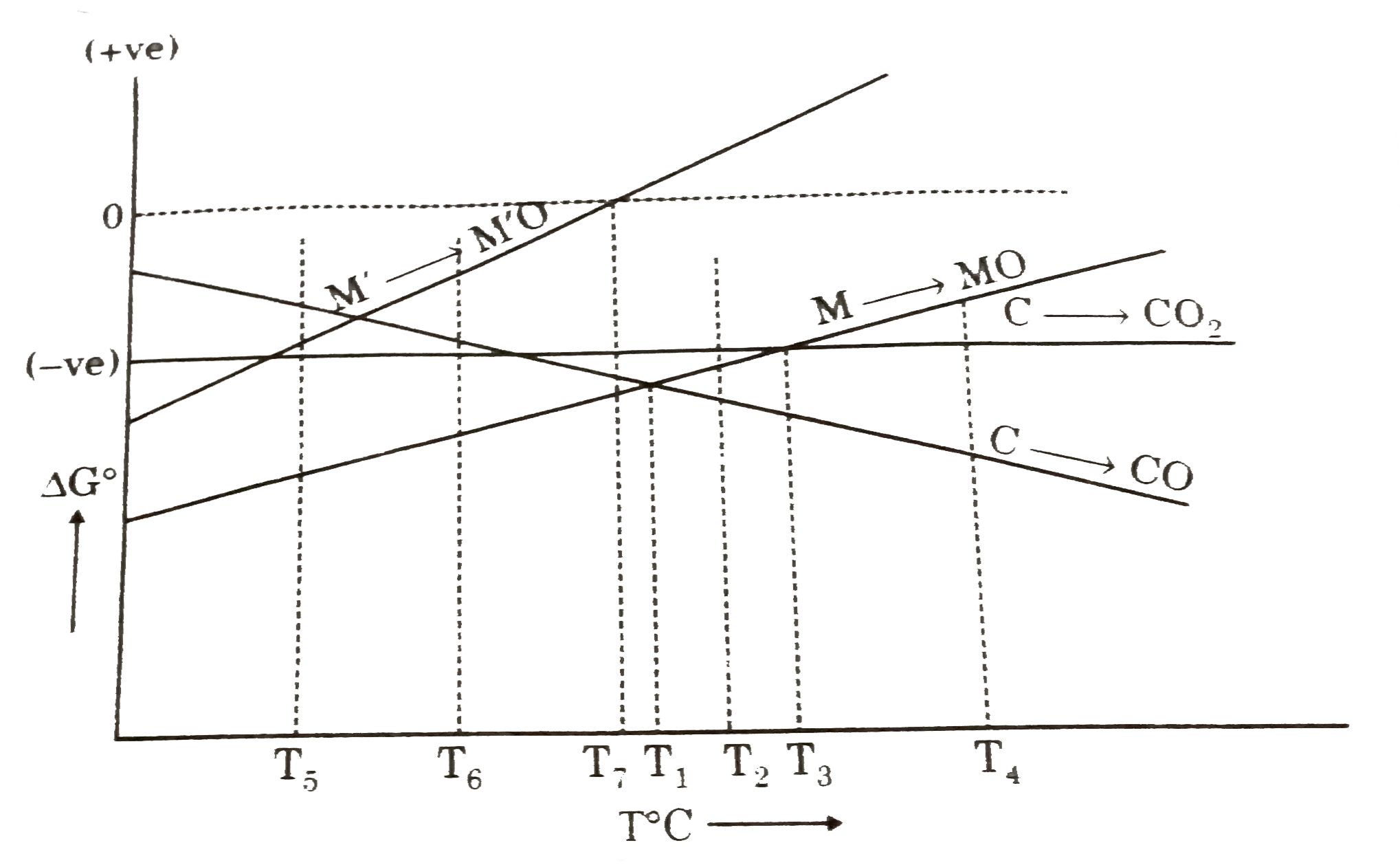

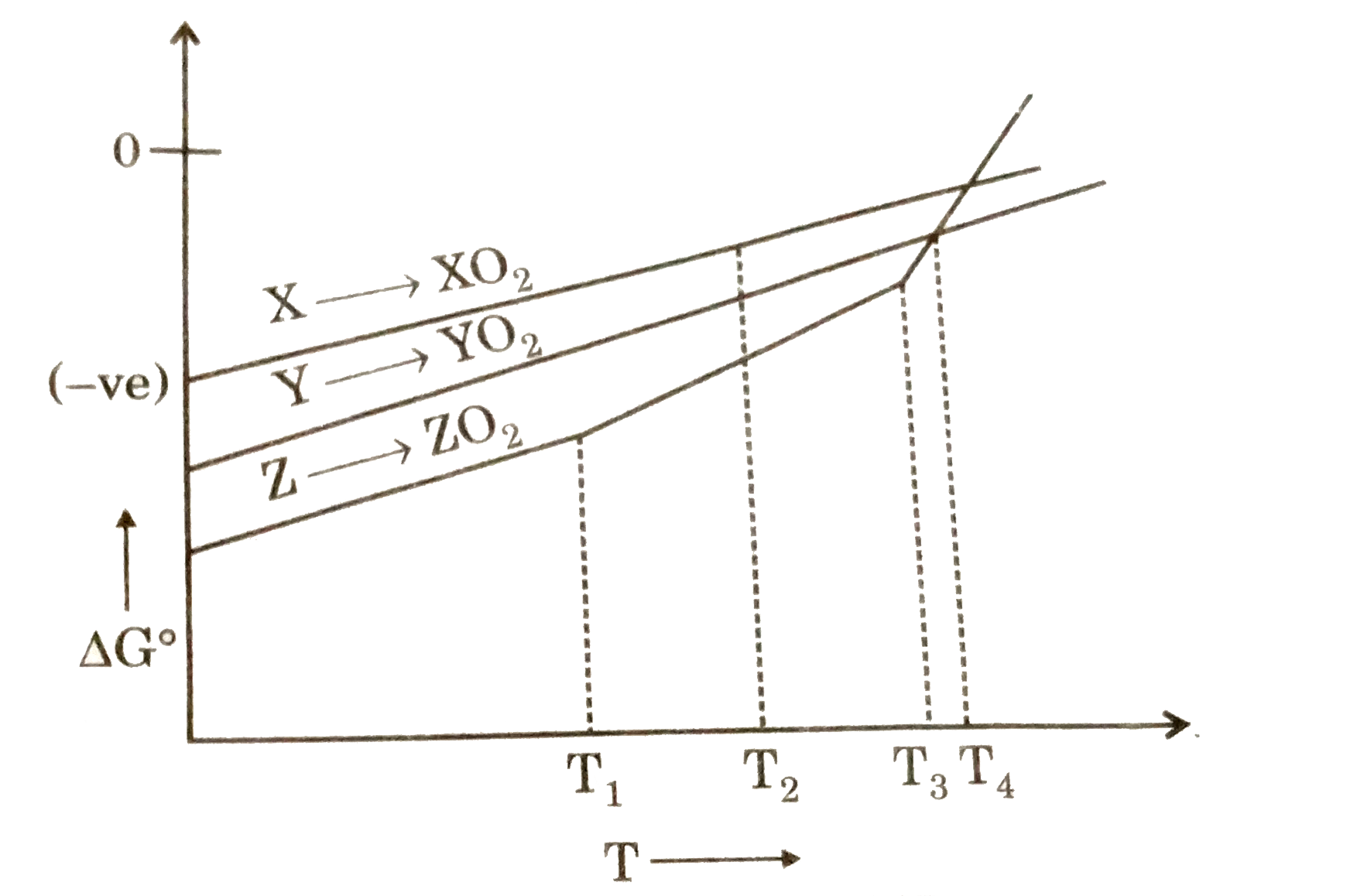
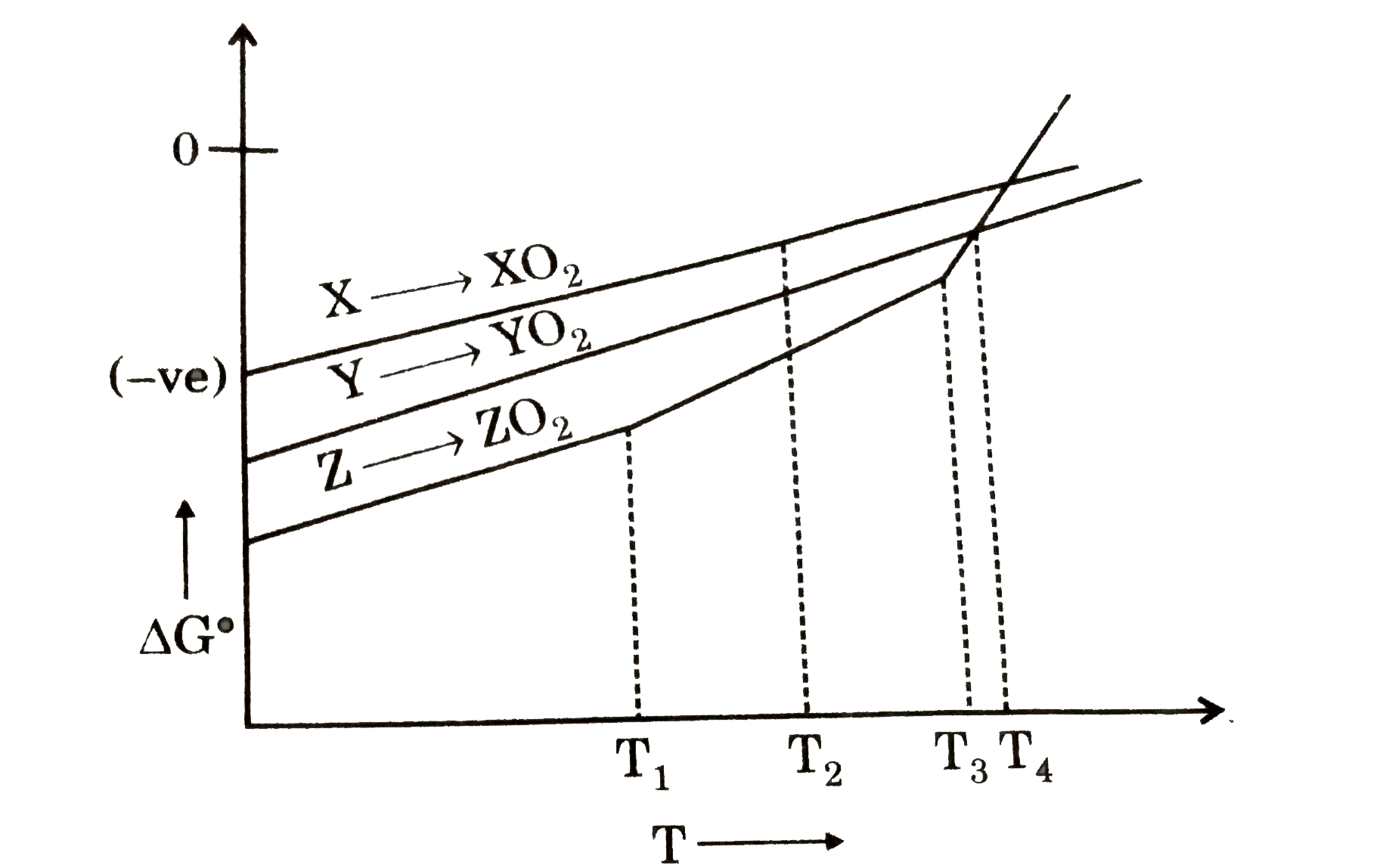










 ltBRgt
ltBRgt 




